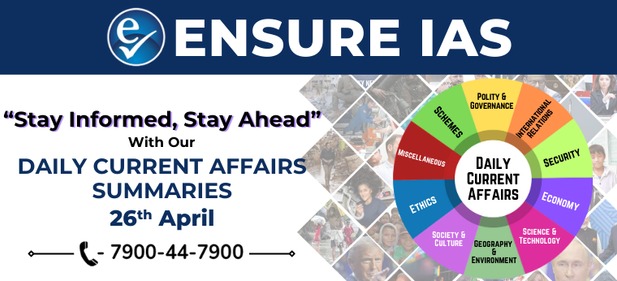- Courses
- GS Full Course 1 Year
- GS Full Course 2 Year
- GS Full Course 3 Year
- GS Full Course Till Selection
- CSAT
- 5 LAYERED ARJUNA Mentorship
- Public Administration Optional
- Online Program
- GS Recorded Course
- NCERT (Recorded 500+ Hours)
- Polity Recorded Course
- Geography Recorded Course
- Economy Recorded Course
- AMAC Recorded Course
- Modern India, Post Independence & World History
- Environment Recoded Course
- Governance Recoded Course
- Science & Tech. Recoded Course
- International Relations and Internal Security Recorded Course
- Disaster Management Module Course
- Ethics Recoded Course
- Essay Recoded Course
- Current Affairs Recoded Course
- ABOUT US
- OUR TOPPERS
- TEST SERIES
- FREE STUDY MATERIAL
- VIDEOS
- CONTACT US
Daily Current Affairs Summary - 25th March 2025
Daily Current Affairs Summary - 25th March 2025

Transgenic Mice in Spotlight Following US President’s Misstatement on ‘Transgender Mice’ Funding
A recent misstatement by the US President, referring to transgenic mice as 'transgender mice', has brought attention to transgenic organisms and their significance in scientific research.
What Are Transgenic Organisms?
- A transgenic organism is one whose genetic material (DNA) has been altered by introducing foreign DNA sequences from another species.
- The term ‘transgenic’ comes from ‘trans’ (meaning across species) and ‘genetic’ (referring to genes), signifying the transfer of genetic traits across different species.
Transgenic Mice and Their Importance
- Why Mice? They serve as a key model in biological research due to their genetic, anatomical, and physiological similarities with humans.
- Applications:
- Understanding Biological Processes: Used to study metabolism, blood cell production, and gene functions.
- Modeling Human Diseases: For example, transgenic pigs are used to study neurodegenerative diseases like Alzheimer's.
- Drug Testing & Treatment Development: Transgenic zebrafish help accelerate drug discovery and therapy research.
- Production of Therapeutic Proteins: Transgenic goats have been engineered to produce human blood-clotting proteins like antithrombin.
- Agricultural Benefits: Bt Cotton, a genetically modified crop, is resistant to bollworm infestations.
|
Understanding the Transgenic Process (Bt Cotton Example) Donor Organism (Bacillus thuringiensis - Bt Bacterium) Produces a CrylAc toxin, toxic to bollworms. ↓ Gene Extraction The gene for CrylAc toxin is isolated from Bt bacterium. ↓ Insertion into a Vector (Recombinant DNA Technology) The extracted CrylAc gene is inserted into a plasmid (vector DNA) to facilitate transfer. ↓ Transformation into Cotton Plant The recombinant DNA is introduced into cotton cells, making the plant genetically modified (transgenic). ↓ Final Outcome – Transgenic Cotton The modified plant produces the Cry protein, which kills bollworms, reducing pesticide dependency. |
Challenges and Concerns with Transgenic Organisms
- Regulatory Framework in India: Governed under the ‘Rules, 1989’ of the Environment (Protection) Act, 1986, with oversight from the Genetic Engineering Appraisal Committee (GEAC).
- Ethical Concerns: Debate over animal welfare and unintended genetic consequences.
- Environmental Risks: Potential ecosystem disruptions, including gene transfer to wild species.
The controversy over the US President’s misstatement has unintentionally highlighted the crucial role of transgenic organisms in scientific advancements. While they offer immense benefits in medicine, agriculture, and research, careful ethical considerations and regulatory measures are essential to ensure their safe and responsible use.
Delhi Adopts National E-Vidhan Application (NeVA) Platform
The Delhi Assembly has joined the National E-Vidhan Application (NeVA) platform, marking a significant step towards a paperless and digitally integrated legislative system.
About NeVA Platform
The National E-Vidhan Application (NeVA) is a digital workflow system designed to streamline and enhance legislative proceedings across India.
Key Aspects of NeVA
- Cloud-Based System: NeVA is deployed on MeghRaj, a cloud infrastructure that ensures secure and efficient functioning of legislative houses.
- Paperless Functioning: It enables legislators to perform their duties digitally, reducing dependence on physical documents.
- Developed by MoPA: The platform has been developed by the Ministry of Parliamentary Affairs (MoPA) to modernize legislative processes.
Features of NeVA
- Device-Agnostic Access: Legislators can use NeVA on smartphones, tablets, and laptops, making legislative work accessible anytime, anywhere.
- Secure Digital Repository: The platform safeguards confidentiality and integrity of legislative data, ensuring secure storage and retrieval.
- Multilingual Support: To cater to India’s linguistic diversity, NeVA provides content in multiple languages, enhancing accessibility for legislators across states.
Anthurium Flowers from Mizoram Exported to Singapore for the First Time
In a significant development, the Agricultural and Processed Food Products Export Development Authority (APEDA) has facilitated the first-ever export of Anthurium flowers from Mizoram to Singapore. This milestone not only promotes India's floriculture sector but also enhances Mizoram’s global trade potential.
About Anthurium
- Diverse and Vibrant: Anthurium is a large group of ornamental flowering plants, known for their striking colors and unique shapes.
- Native Origin: These plants originate from tropical America, thriving in warm and humid environments.
- Significance in India: In India, Mizoram is a key region for Anthurium cultivation, where the flower holds economic and cultural importance.
Air Purification Benefits
- Recognized by NASA: Anthurium is listed by NASA as an air-purifying plant.
- Removes Toxins: It effectively filters harmful airborne chemicals such as formaldehyde, ammonia, toluene, xylene, and allergens, contributing to healthier indoor air quality.
Mizoram’s Anthurium Festival
- Annual Celebration: Mizoram hosts the Anthurium Festival each year to promote tourism and showcase the flower’s ornamental and commercial value.
- Cultural and Economic Boost: The festival not only highlights the beauty of Anthurium but also provides opportunities for local farmers and businesses to expand their reach.
Shaheed Diwas: Honoring the Sacrifice of Bhagat Singh, Rajguru, and Sukhdev
Every year on March 23, India observes Shaheed Diwas (Martyr’s Day) to pay tribute to the legendary freedom fighters Bhagat Singh, Rajguru, and Sukhdev, who
sacrificed their lives for the nation’s independence.
Significance of Shaheed Diwas
- The day marks the execution of Bhagat Singh, Sukhdev Thapar, and Shivaram Hari Rajguru in 1931.
- They were sentenced to death by the British colonial government for their involvement in the assassination of John Saunders, a British police officer, in 1928.
- Their execution sparked nationwide protests and further strengthened India's struggle for independence.
Revolutionary Leaders and Their Contributions
Bhagat Singh
- A visionary thinker, he was deeply influenced by Marxist and socialist ideologies, drawing inspiration from figures like Karl Marx, Vladimir Lenin, Leon Trotsky, and Mikhail Bakunin.
- He founded the Naujawan Bharat Sabha, an organization dedicated to mobilizing youth for India’s freedom movement.
Sukhdev Thapar
- An active member of the Hindustan Socialist Republican Association (HSRA).
- Played a crucial role in establishing revolutionary networks across Northern India, organizing secret cells to fight against British rule.
Shivaram Hari Rajguru
- A prominent member of HSRA, known for his unwavering dedication to the revolutionary cause.
- He was skilled in armed resistance and played a key role in the Lahore Conspiracy Case, which led to the execution of the three revolutionaries.
The sacrifice of Bhagat Singh, Rajguru, and Sukhdev continues to inspire generations, symbolizing courage, patriotism, and resistance against oppression. Their legacy remains an integral part of India's struggle for freedom, and Shaheed Diwas serves as a reminder of their invaluable contribution to the nation.
Discovery of Sheathia rosemalayensis: A New Freshwater Algae Species
Researchers have identified a new species of freshwater algae named Sheathia rosemalayensis. This rare species was discovered in Rosemala, a region in the Western Ghats of Kerala, and has been named after its place of origin.
Significance of Sheathia rosemalayensis
- Rare Occurrence in India: The Sheathia genus is extremely rare in India. Before this discovery, only one other species had been recorded, which was found in the Himalayas.
- Freshwater Habitat: This species contributes to the biodiversity of freshwater ecosystems in the Western Ghats, a recognized global biodiversity hotspot.
Understanding Algae
- Diverse and Widespread: Algae are a varied group of photosynthetic organisms found in aquatic and moist environments.
- Range in Size: They include microscopic phytoplankton as well as large seaweeds like kelp.
- Ecological Importance:
- They produce oxygen, playing a crucial role in maintaining atmospheric balance.
- They form the foundation of the aquatic food chain, supporting diverse ecosystems.
Vinod Kumar Shukla Selected for the 59th Jnanpith Award
Renowned writer Vinod Kumar Shukla has been chosen as the recipient of the 59th Jnanpith Award, the highest literary honor in India. This prestigious award recognizes his outstanding contribution to Indian literature.
About the Jnanpith Award
- The Jnanpith Award is an annual literary honor presented by Bharatiya Jnanpith, a leading literary organization established in 1944.
- Instituted in 1965, the award celebrates exceptional literary contributions across India's diverse linguistic landscape.
- It is considered the highest literary award in the country and is conferred upon writers for their creative excellence in any of the 22 languages recognized under the Indian Constitution.
- Since 2013, works in the English language have also been considered for the award.
- The award is exclusively given to Indian citizens who have made remarkable contributions to literature.
Concerns Over AI Washing in Startups
Venture capitalists are increasingly worried about AI washing, a deceptive practice used by startups to attract funding by exaggerating or misrepresenting their use of artificial intelligence.
What is AI Washing?
- AI washing refers to the misleading portrayal of artificial intelligence in a company’s products, services, or strategies. Startups and businesses often use this tactic to appear more innovative or technologically advanced than they actually are.
- The term "AI washing" is derived from "greenwashing," where companies make false or exaggerated claims about their environmental impact to gain consumer trust or investment.
Common Examples of AI Washing
- Mislabelling Automation as AI: Simple rule-based automation systems being falsely advertised as advanced AI-powered solutions.
- Superficial AI Claims: Companies claiming to use AI without any substantial machine learning or intelligent processing involved.
- Overuse of Buzzwords: Excessive use of terms like “AI-driven,” “intelligent,” or “machine learning-powered” without actual AI implementation.
As AI continues to dominate the tech industry, investors and regulators are becoming more vigilant in identifying genuine AI innovation versus marketing hype.
Discovery of Berkelocene: A Unique Organometallic Molecule
Scientists have recently identified and characterized berkelocene, the first known organometallic molecule containing the heavy element berkelium. This breakthrough enhances our understanding of actinide chemistry and expands the study of organometallic compounds.
What Are Organometallic Molecules?
Organometallic compounds are molecules that contain a direct bond between carbon and a metal atom. These compounds are distinct because they merge the characteristics of both metals and organic (carbon-based) molecules.
Key Properties of Organometallic Compounds
- Reactivity to Air and Moisture: Many organometallic molecules are highly sensitive and can degrade upon exposure.
- Thermal Stability: Some compounds can withstand high temperatures, but their stability varies depending on their chemical structure.
- Electrical Conductivity: Certain organometallic compounds can conduct electricity, making them valuable in electronic applications.
- Catalytic Function: They are widely used as catalysts in chemical reactions, accelerating processes without being consumed.
The discovery of berkelocene adds to the growing field of organometallic chemistry and opens new avenues for research in actinide-containing materials.
India Imposes Anti-Dumping Duties on Chinese Goods
Understanding Anti-Dumping Duties
Anti-dumping duties are tariffs imposed on imported goods that are sold below their fair market value, a practice known as "dumping." This measure is taken to protect domestic industries from unfair competition and predatory pricing by foreign exporters.
Why Are Anti-Dumping Duties Imposed?
- Prevent Unfair Trade Practices: Ensures that foreign companies do not engage in price undercutting to drive out domestic competitors.
- Safeguard Domestic Industries: Protects local manufacturers from financial losses due to artificially low-priced imports.
- Encourage Fair Market Competition: Maintains a level playing field for businesses by discouraging exploitative pricing tactics.
WTO Regulations on Anti-Dumping Measures
- Legal Framework: Article VI of the General Agreement on Tariffs and Trade (GATT) 1994 permits anti-dumping duties under certain conditions.
- Investigation Criteria: A government must conduct an investigation to establish three key factors:
- Dumping: Proof that imported goods are priced below their fair value.
- Injury: Evidence that domestic industries are suffering losses due to dumped imports.
- Causal Link: Demonstration that the injury is directly caused by the dumped goods.
- Temporary Nature: Anti-dumping duties are not permanent and must be periodically reviewed to assess their necessity.
By imposing anti-dumping duties on multiple Chinese goods, India aims to protect its domestic industries from unfair trade practices while ensuring compliance with international trade regulations.
Social Media Company X Challenges Union Government Over IT Act Violations
- A prominent social media company, X, has filed a lawsuit against the Union Government, challenging the use of Section 79(3)(b) of the Information Technology (IT) Act, 2000.
- The company argues that the government’s approach to regulating and removing content on social media bypasses the procedural safeguards outlined under Section 69A, thereby raising concerns over free speech and legal compliance.
Understanding Section 79 & Section 79(3)(b) of the IT Act
- Section 79 (Safe Harbour Protection): Provides legal immunity to internet intermediaries, protecting them from liability for user-generated content.
- Section 79(3)(b) (Exception to Safe Harbour): If an intermediary fails to remove or block unlawful content after receiving a government notification, it loses its safe harbour protection, making it liable for the content.
What is Section 69A of the IT Act?
- Government's Blocking Powers: Section 69A allows the government to issue orders for blocking content, but only on grounds specified under Article 19(2) of the Constitution, which permits reasonable restrictions on free speech.
- Shreya Singhal Judgment (2015): The Supreme Court ruled that content can only be blocked through either Section 69A's prescribed procedure or a court order.
MeitY’s Directive and the ‘Sahyog’ Portal
- In 2023, the Ministry of Electronics and Information Technology (MeitY) issued a directive to ministries, state governments, and police authorities, stating that information-blocking orders could be issued under Section 79(3)(b).
- In 2024, the ‘Sahyog’ portal was launched to enable government agencies to issue and upload content-blocking orders.
Concerns Raised by Social Media Company X
- Misinterpretation of Section 79(3)(b):
- The provision does not grant the government direct power to block content.
- It only specifies when an intermediary loses safe harbour protection, not an independent blocking mechanism.
- Violation of Supreme Court Guidelines:
- The Shreya Singhal judgment established that content blocking must follow due process under Section 69A or be backed by a court order.
- MeitY’s directive bypasses these safeguards and treats Section 79(3)(b) as a direct content-blocking tool.
Why This Case Matters?
This legal battle highlights critical issues surrounding online free speech, government regulation, and intermediary liability. The outcome could have far-reaching implications for digital platforms, content moderation policies, and the interpretation of India's IT laws.
Fertilizer Subsidy Cuts Raise Concerns Over Agricultural Security
Funding Shortfall in Fertilizer Subsidy
- A recent committee report has raised concerns over the Ministry of Finance’s decision to reduce the projected outlay for fertilizer schemes in 2025-26.
- The Department of Fertilizers had proposed an allocation of approximately ₹1.84 lakh crore, but this was reduced by nearly 7%.
- The cuts have impacted both the Nutrient-Based Subsidy (NBS) Scheme and the Urea Subsidy Scheme, raising questions about future fertilizer availability and affordability.
Key Observations from the Report
- Fertilizer Security Challenges: Global supply chain disruptions and price volatility have led to shortages of essential fertilizers like Di-Ammonium Phosphate (DAP).
- Mining and Technological Gaps: Lack of progress in securing mining leases for critical raw materials like phosphates and potash has hindered self-reliance.
- Soil-Specific Fertilizer Needs: Farmers face higher costs due to the unavailability of customized NPKS (Nitrogen-Phosphorus-Potassium-Sulphur) fertilizer grades.
- Concerns Over DBT Implementation: The current Direct Benefit Transfer (DBT) mechanism lacks a robust verification system, leading to potential misuse.
- Emerging Nano Fertilizers: While Nano Urea and Nano DAP show promise in enhancing crop yields, further research is required before large-scale adoption.
Recommendations
- Balanced Supply and Distribution: Enforce compliance on fertilizer supply with penalties for violations while promoting distribution based on soil-specific needs.
- Early Warning System for Fertilizer Crisis: Establish a Fertilizer Crisis Early Warning System (FCEWS) to predict shortages and maintain buffer stocks.
- Targeted DBT Implementation: Integrate Aadhaar authentication with the Farmer’s Registry to prevent misuse and implement dynamic purchase limits based on landholding size.
- Promotion of Urea Gold: Encourage the use of Urea Gold, an improved variant that enhances soil health and crop yield while reducing dependency on conventional urea.
Nutrient-Based Subsidy (NBS) Policy
- Fixed Subsidy Per Nutrient: Provides financial support for Nitrogen (N), Phosphorus (P), Potash (K), and Sulphur (S), with periodic revisions.
- Wide Coverage: Includes 28 grades of P&K fertilizers like DAP, Mono Ammonium Phosphate (MAP), and Muriate of Potash (MOP).
- Market Pricing: Manufacturers determine Maximum Retail Prices (MRP), subject to government oversight for affordability.
- Micronutrient Support: Additional subsidies are available for essential micronutrients such as Boron and Zinc.
Urea Subsidy Scheme
- Ensuring Affordability: Keeps Urea prices low for farmers, crucial for maintaining food security.
- Boosting Domestic Production: Prioritizes self-sufficiency in Urea manufacturing to reduce reliance on imports.
Also Read
FREE NIOS Books




